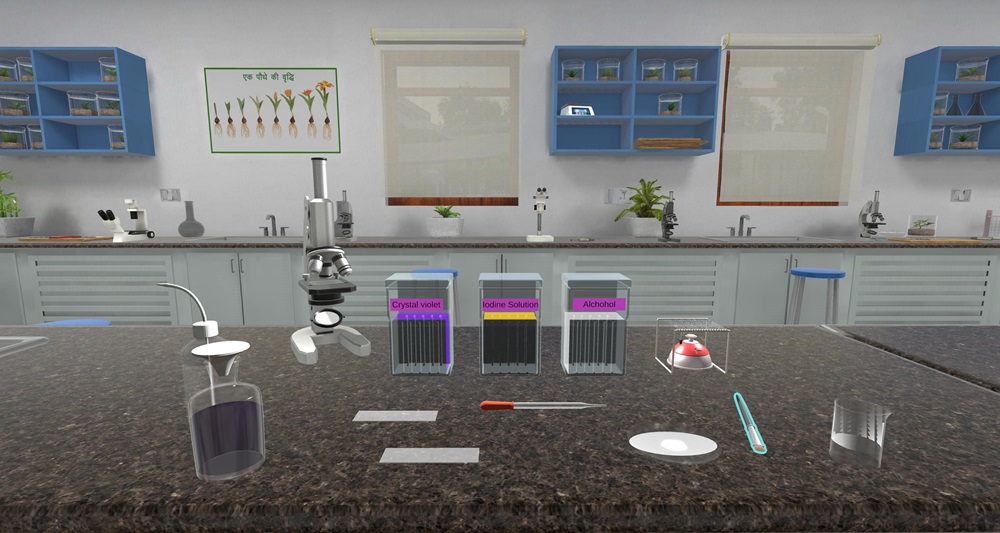Teach Bacterial Staining with Engaging Virtual Reality Tools

Technology is no longer a luxury in the ever-changing world of education, it is a necessity. The problem with bacterial staining is that it is complex and difficult to make accessible and engaging for seasoned academicians and educators.
Bacterial Staining with VR is a new way to allow microbiology education to become more immersive. There is a reason why the best educators at premier institutions like Michigan State University are rooting for VR implementation in bacterial staining.
In this blog, we will take a closer look at the challenges of traditional bacterial staining in labs and explore how exactly VR solutions can help solve the issues in this regard.
Let’s get started.
Loopholes In Traditional Bacteria Stain Techniques In The Lab
To understand the role of simulated labs in stem education in simplifying the bacterial stain processes in labs, it is important to know what the gaps in the traditional method are in the first place.
Let’s take a look-
☑️ Demonstrating Microscopic Techniques:
Traditional teaching methods are often ineffective in demonstrating microscopic techniques at the educators’ disposal. A Television survey of its users found that 39 percent of respondents experienced sample loss during the gram-staining process.
The most common cause of this is smearing the sample too thickly on the slide so that it is not properly adhering to the slide during fixation.
☑️ Limited Resources:
Constraints in laboratory resources are common at many educational institutions. A survey in low- and middle-income countries (LMICs) found that 43% of clinical microbiology laboratories lacked enough laboratory equipment to perform essential diagnostic tests.
☑️ Diverse Learning Styles:
Learning styles among students are diverse and challenging for educators to connect to all learners. Some students prefer the auditory mode, while others might be more attuned to the visual elements in instructional design.
Finding a common ground so that every learner can get adequate resources to acquire the necessary skills is a challenge faced by most educators today.
Want to transform your teaching of bacterial staining? Connect with us to see how virtual reality can revolutionize your classroom!
Reason For The Introduction of VR In Bacterial Staining
Let us go through the benefits of VR labs that are proving to be a blessing for educators and academicians all across the world-
☑️ Simulations of Immersive Bacterial Staining
Immersive learning environments have been supported by research. A study published in Scientific Reports found that VR had a significant and moderately positive effect on the practical skills learning of science and engineering students. The comprehensive effect size was 0.477.
This statistic shows that VR learning modules for bacterial staining have the potential to let students visualize and interact with bacterial structures in 3D, adhering to the principles of Education 4.0 (active learning).
The same applies to other related aspects, like nursing education simulation, gynecological training, or DNA extraction.
☑️ Real-World Applications
An engineering college where students study microbial contamination in water systems is easy to imagine. Virtual bacterial staining techniques allow them to apply gram-staining on different water samples but without the physical lab equipment.
Moreover, an advantage of this approach is that it lowers costs while inviting experimentation and deeper understanding.
☑️ Boosting Student Engagement
Effective learning is based on engagement. According to studies, 82% of students prefer interactive learning methods over passive lectures.
Immersive bacterial staining simulations allow students to be actively involved in the staining process while applying virtual tools to apply stains and view results in real-time. Also, this fulfills Education 4.0's theory that insists on student student-centered learning environment.
Not only this, but even while teaching human anatomy, VR is a handy tool. It eliminates the need for dissecting human cadavers. This paves the way for more ethical methods of teaching.
Successful Implementations: Use Cases
Several institutions have successfully integrated VR into their microbiology curricula:
☑️ Michigan State University:
Through a Virtual Interactive Bacteriology Laboratory, students can perform tests such as Gram staining to improve their diagnostic skills by means of realistic simulations.
☑️ New Mexico State University:
Virtual labs through the university provide students the opportunity to practice bacterial sampling and then Gram staining techniques.
☑️ Purdue University
VR has been used in Purdue’s science education programs, including microbiology. Students are also able to practice techniques such as gram-staining in a virtual, controlled environment that is part of their VR labs which leads to improved skill acquisition and confidence.
These are just a few examples illustrating that VR is not just an innovative tool anymore, but without it, modern education cannot exist.
☑️ Connecting Theory to Practice
Introducing VR into bacterial staining education helps to bridge the gap between the theoretical and the practical. Students can directly apply theoretical concepts learned in lectures to virtual experiments when students engage with simulated lab training in Microbiology.
The learning outcomes are reinforced through this hands-on experience and prepare them for real-world applications.
Summing up the key takeaways from the blog-
VR tools support higher engagement of students with 82% of learners preferring interactive methods over traditional lectures, in line with Education 4.0 principles.
About 43% of clinical labs do not have the required equipment. VR transforms science education by reducing the constraints in microbiology labs and providing accessible virtual lab experiences.
VR fills the gap between theory and practical application and enables students to practice simulated lab training and strengthen learning outcomes.
Stellar institutes such as Michigan State University, New Mexico State University, and Purdue University, are using VR to assist in skills acquisition and increase student confidence in techniques like Gram staining.
Conclusion:
With a fast-moving technology like bacterial staining with VR, such an initiative can also improve microbiology education as we venture further into the coming age of technology.
By offering immersive and involving students in experiences, educators can encourage students to have a more expansive understanding of the more complex subjects and prepare them for what lies ahead.
.png)




